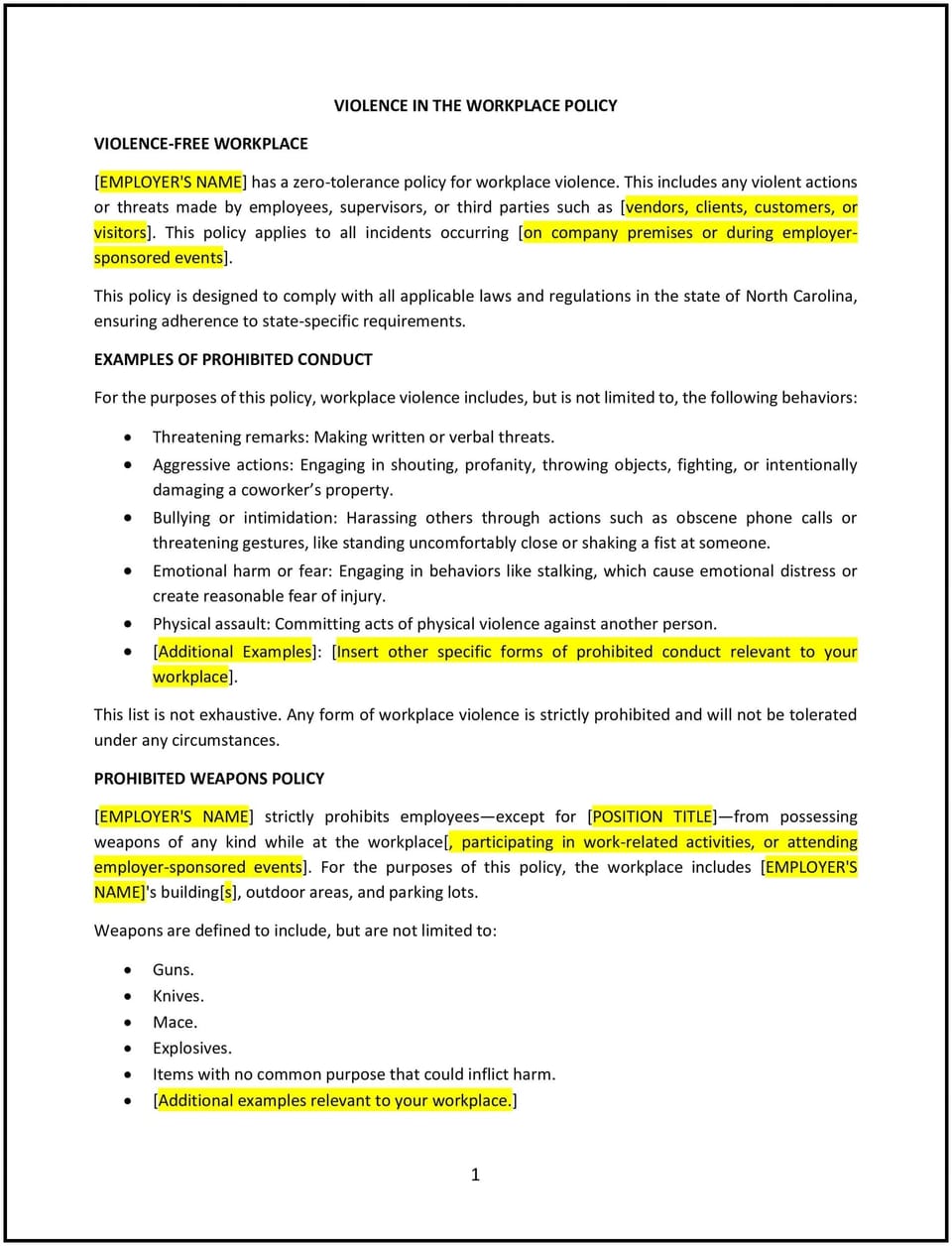Violence in the workplace policy (North Carolina): Free template

Violence in the workplace policy (North Carolina)
This violence in the workplace policy is designed to help North Carolina businesses create a safe and secure work environment by addressing and preventing workplace violence. It outlines procedures for reporting, investigating, and resolving incidents of violence.
By adopting this policy, businesses can protect employees, reduce risks, and foster a culture of safety and respect.
How to use this violence in the workplace policy (North Carolina)
- Define workplace violence: Clearly explain what constitutes workplace violence, such as physical assault, threats, or harassment.
- Establish reporting procedures: Provide steps for employees to report incidents of violence, including anonymous reporting options.
- Outline investigation processes: Describe how violence complaints will be investigated, ensuring fairness and confidentiality.
- Specify consequences: Define the disciplinary actions for confirmed violence, such as warnings, suspension, or termination.
- Train employees and managers: Educate staff on recognizing and preventing workplace violence, and train managers on handling complaints effectively.
- Promote awareness: Regularly communicate the policy to employees and include it in the employee handbook.
- Review and update: Assess the policy annually to strengthen alignment with evolving workplace dynamics and legal standards.
Benefits of using this violence in the workplace policy (North Carolina)
This policy offers several advantages for North Carolina businesses:
- Protects employees: Creates a safe work environment by addressing and preventing workplace violence.
- Reduces risks: Minimizes the likelihood of violent incidents, protecting employees and the business.
- Enhances trust: Demonstrates a commitment to employee safety and well-being.
- Promotes accountability: Establishes clear procedures for reporting and addressing workplace violence.
- Builds trust: Shows employees that the business values their safety and contributions.
Tips for using this violence in the workplace policy (North Carolina)
- Communicate clearly: Ensure all employees understand the policy and their responsibilities in preventing workplace violence.
- Provide training: Educate employees and managers on recognizing and addressing potential violence.
- Encourage reporting: Foster a culture where employees feel safe reporting incidents without fear of retaliation.
- Monitor trends: Track incidents to identify patterns and address underlying issues.
- Update regularly: Review the policy annually to strengthen alignment with evolving workplace dynamics and legal standards.
Q: How does this policy benefit businesses?
A: It protects employees, reduces risks, and fosters a culture of safety and respect in the workplace.
Q: What constitutes workplace violence?
A: Workplace violence includes physical assault, threats, harassment, or any behavior that creates a hostile work environment.
Q: How are incidents of violence reported?
A: Employees can report incidents to their supervisor, HR, or through anonymous reporting channels.
Q: What happens if an employee violates this policy?
A: Violations may result in disciplinary action, such as warnings, suspension, or termination, depending on the severity.
Q: How often should businesses review this policy?
A: Businesses should review the policy annually or as needed to strengthen alignment with evolving workplace dynamics and legal standards.
This article contains general legal information and does not contain legal advice. Cobrief is not a law firm or a substitute for an attorney or law firm. The law is complex and changes often. For legal advice, please ask a lawyer.


